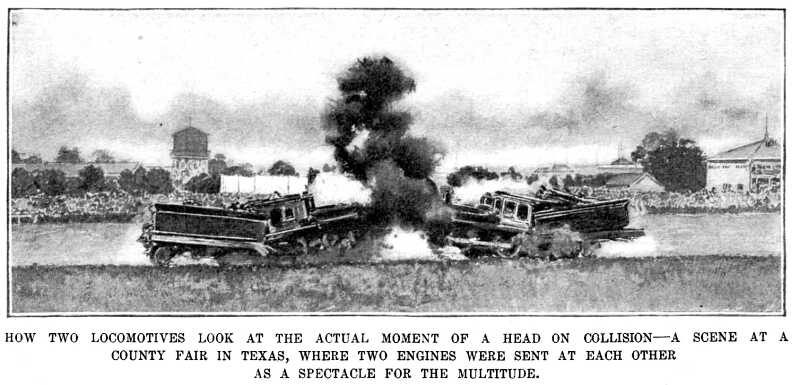|
||||||
  
 | ||||||
|
By George Hebard Paine 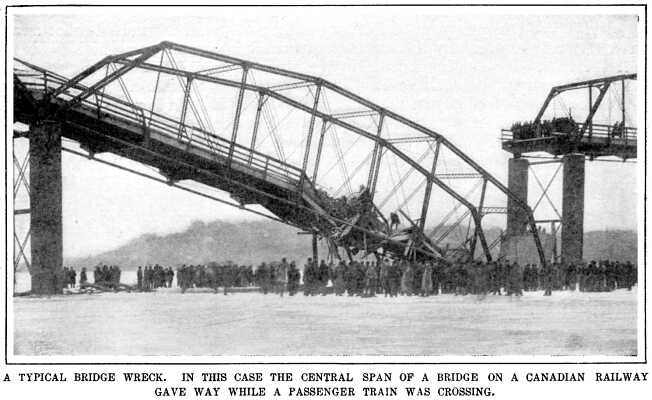
How Wrecks Occur, and How, by Systematized Work, a Blocked Track is Cleared in the Shortest Possible Time.
It was a discouraging sight which met the wrecking crew. Of the bridge there was nothing left but scrap, and cars were thrown around in every conceivable sort of confusion and dismemberment. The tramps had been found—one died while being rescued, the other two were already dead—and pulled out of the chaos of kindling wood and twisted rods which was all that was left of the car in which they had been stealing a ride. A car load of racing horses had rolled down the bank and was a kicking groaning mass of maimed and struggling animals. This was bad enough, one would think, but the situation was made stilt worse by the absence of the only person who was qualified to grasp the whole affair; and, last but not least, the nearest derrick powerful enough to lift a car body was almost a hundred miles away, engaged in cleaning up another wreck. In consequence of this disorganized condition of affairs, the division engineer found himself forced to assume work which under ordinary circumstances was entirely outside of his department. So he set about clearing up the wreckage with such facilities and men as were at hand, including the track forces, who began coming in on their hand cars shortly after the arrival of the wrecking train. It must be understood here that in times of' sudden need on a railway, all the working forces are expected to turn their bands to the thing which may seem to be of the most importance at the moment. But at this wreck there was work enough and to spare for every one in his own department if the forces had been properly balanced and supplied with the proper tools. While the engineer was sitting in the portable telegraph office—which forms a part of every wrecking outfit—sending some messages for repair material, and trying to put the tangle of affairs into a semblance of order, he heard a sound, an unmistakable sound, which was also heard by the telegraph operator at the same moment. It was the whistle of an engine, apparently moving at high speed, and it said, as plainly as if the engine-man had shouted it in so many words, that brakes were wanted, and wanted in a hurry.
But there was no catastrophe. Why not, it is beyond the powers of mortal man to conceive, for here was a train load of ten passenger cars, filled with excursionists, as only excursionists will consent to be packed, and running at a speed of not less than forty miles an hour up to within a hundred and fifty feet of the broken bridge. When, in an agony of apprehension, the engineer dragged himself to the locomotive, he found that the engine-man and fireman, instead of being two unrecognizable lumps of boiled or roasted flesh, as all the circumstances seemed to require, were calmly walking around their machine, trying to form an estimate of the damage. This, as was soon discovered, amounted to absolutely nothing. So far as could be seen, not a pipe was bent, there was not a scratch on the paint, and, after rounding up the passengers, it was found that not even one of them had been jarred. The locomotive had ridden out over the wreckage and rested upon it in a perfectly upright and normal position, except that it was supported by the debris which filled the opening that the bridge had spanned, instead of by the rails.
The details of these two occurrences have been given with some particularity because they contain the elements of so many thousand others. The first had two contributory causes: "defects of the equipment" originally—since the derailment of the car was undoubtedly due to some break in one of its parts—and "defects of the road," because, with a modern bridge floor in place of the ancient stringer construction which was in use there, the car would probably have gone across without disaster.
In addition to this, it transpired that the passenger train had stopped at a train dispatcher’s office, not five miles from the obstruction, had remained there for nearly ten minutes, and yet not a soul had given warning of the danger, although one might reasonably expect that it would be the principle topic of conversation. But it is just such conditions that most wrecks are born, and the reader may rest assured that there is nothing new, strange, or startling about any of the facts presented here. They were selected for the simple reason that they are illustrative. Neglect and disobedience are the parents of nearly all railway disasters that are not due to the elements or to defects in the road and the equipment; and some even of the latter class have the same pedigree.
CURIOUS FEATURES OF TRAIN WRECKS.
But if things which happen to cars and locomotives are remarkable, some of the escapes of human beings are still more extraordinary. The writer has himself seen a man extended from the center of a wreck in which he was so closely embraced that it was necessary literally to chop the timbers and saw off the rods which bound them together, yet he was neither scratched nor bruised; not even his clothing was torn. Another man, who was riding on the top of a freight car when a collision occurred was picked up beside the track, nearly naked, covered with cuts on his head, arms, legs, back and chest. He was unconscious, and at first was supposed to be dead; but it was discovered that, in spite of his horrible appearance, there was nothing seriously the matter with him, for no joint was sprained, no bone was broken, and in a week he was as well as ever. From the circumstances of the Ashtabula disaster, it is perhaps as strange as anything can well be that any one should have escaped alive from both the fall and the fire—or holocaust, as the newspapers of the day called it. Yet nearly one hundred and fifty people fell seventy-five feet, almost half of them were rescued alive, many were not permanently injured, and at least five were not hurt at all.
At nearly every divisional headquarters on a railway, a wrecking plant of more or less completeness is maintained, and is supposed to be kept ready for instant service. It consists, first and foremost, of a derrick, mounted on a flat car, and usually worked by a hand winch, although recent years steam derricks have been adopted by the more progressive lines. Next to the derrick comes the tool car, in which are stored, in exact order and in their proper places, ropes, blocks, screw and hydraulic jacks, saws axes, and whatever else has been found to be useful in an emergency.
A third car sometimes forms a permanent part of the wrecking train. This is a supply car loaded with various kinds of track materials, such as ties, rails, splices, spikes, bolts, a frog or two, and perhaps some sticks of large lumber for trestling. But many railways prefer to collect materials of this sort for each occasion and in the exact quantities needed to repair the damage. The wrecking train has its own storage track assigned to it, and is always kept coupled up. The storage track is either quite near the main track, or in such a relation to the main track that it can be easily reached; and, since the derrick car must always be run in advance, so as to be next to the wreck, it is generally arranged that the storage track shall also be near a turntable. Besides being the most convenient point for storing the wrecking train, the divisional headquarters are the best place for another important reason. Shops of greater or less magnitude are almost always located there, and the force employed in them, the men who make "repairs while you wait" to damaged cars, are found to be the handiest and best equipped with the knowledge and experience necessary for disentangling a snarl of wreckage; and it is from this force that the wrecking gang is largely recruited. Usually their names and residences are posted in some conspicuous place, so that the "caller"—whose duty is to notify trainmen when it comes their turn to go out—can be started off to rouse them at a moment’s notice. THE ART OF CLEARING THE TRACKS.
But the most advanced state of the art is not seen except where both tracks of a double track line are blocked by a bad wreck, and a separate crew is employed at either end, each striving, straining, struggling to outdo the other. Each foreman is proud of his gang, and anxious to have them do their best; each gang has bragged time out of mind about its foreman, and believes him the smartest on earth. They have met before, and each has claimed the victory, but here is the chance to settle the matter beyond peradventure. And how they drive! A pull in just he right way, and a truck sneaks out from a seemingly inextricable mass; three slings around an overturned box-car, and it rises bodily into the air. Something measurable is being done continually, an advance is visible almost from moment to moment, and chaos insensibly assumes the appearance of regularity. While the wrecking gang is at work clearing up the mess, the trackmen are quite as busy, for in a bad wreck the track is almost more or less injured, and sometimes practically destroyed; and it must be put into some sort of shape in order that the derrick may be kept close to its work. Usually, however, the trackmen are not able to exercise their functions immediately, because the outside fringe of the wreck must first be cleared away by the other workers. It may be taken as a law that they most important object to be attained, when the track is obstructed, is the resumption of traffic in the shortest possible time. To an uninstructed onlooker, the methods practised at a collision or washout must often appear wasteful in the extreme. But when it is understood that the mere stoppage of travel at an insignificant culvert, which may have not been large enough to carry the water sent down by a cloudburst, entails a loss of revenue many times greater than the mere cost of repairs, it is evident that what may seem a wasteful plan may be actually the cheapest in the end, if it appreciably shortens the period of delay. Many a wreck has been set on fire as the simplest solution of a knotty problem, and it is not unusual to span the opening left by a sliding embankment with perfectly new cross ties in the form of crib work. Where the ground will permit, it is a common practice to build an entirely new track around an obstruction, since it enables the wrecking crew to work with more deliberation, and with an eye to saving as much as possible, instead of forcing them to bend their whole energy in getting the track clear. THE CAUSES OF RAILWAY WRECKS.
It is often a difficult matter to determine the exact cause of a wreck, and the reasons for many of the most fatal disasters are still more or less debatable, and will always remain so. It easy to see why this must be so, when it is remembered that where there are defects of road or equipment, the derailing of the train is likely to destroy all the evidence. It will never be absolutely known what it was that precipitated a not unusually heavy train into the abyss of Ashtabula. Many engineers concluded that the bridge was overloaded. Others, equally well informed, were convinced that the terrific gale which was blowing at the time actually lifted the bridge from its bearings; this would have disturbed some of the joints in the top chord, and allowed the structure to fall apart when it settled back. The accident at Garrison’s, New York, in which eighteen persons lost their lives, was just as mysterious, if not more so. Having dealt with horrors so generously in the preceeding pages, it is a distinct pleasure to close this paper with the reassuring statement that, according to the report of the Interstate Commerce Commissioners for the year ending June 30, 1899, but one passenger out of every 2,200,000 was killed on the railways of the United States. And so well is the essential safety of railway travel understood, that many of the accident insurance companies embody a clause in their policies which doubles the ace value of the contract in the event of an injury to the insured while riding in any public vehicle propelled by steam or electricity.
Railroad Accidents | Contents Page
This page originally appeared on Thomas Ehrenreich's Railroad Extra Website
|
||||||
|
|
|
|||||



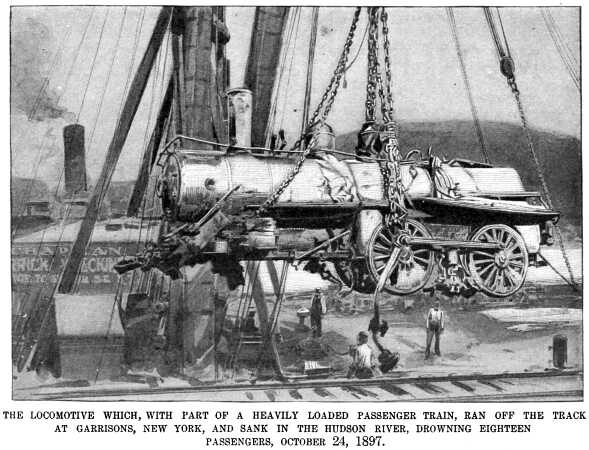
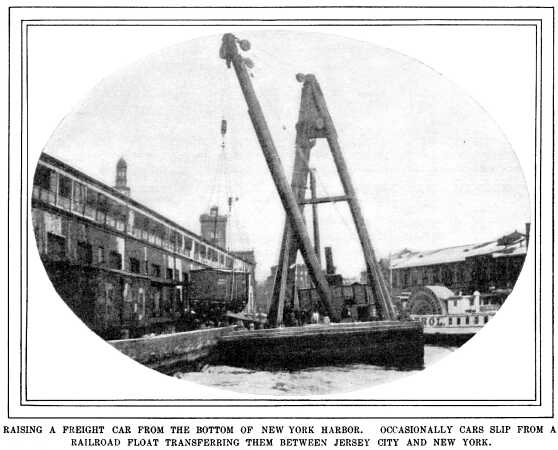 This is a typical
case. Bridge 64 was old and under suspicion, for it had been reported
"unfit for repairs" many, many times. The reason why
it was not rebuilt was an excellent one, but is of no importance
here. It is important, however, to remark that investigation proved
the bridge not to have fallen down, but to had been knocked down
by a derailed car, whose marks were found on the cross ties for
a distance of three quarters of a mile back from the wreck. And,
bad as it was, it was found that the structure had actually carried
two cars across after having been seriously crippled by the car
that left the rails. It was also proved that all of the trainmen
must have been in the caboose, instead of out on the train, or
some one would have seen the behavior of the car, and probably
have been able to stop the train and prevent the wreck.
This is a typical
case. Bridge 64 was old and under suspicion, for it had been reported
"unfit for repairs" many, many times. The reason why
it was not rebuilt was an excellent one, but is of no importance
here. It is important, however, to remark that investigation proved
the bridge not to have fallen down, but to had been knocked down
by a derailed car, whose marks were found on the cross ties for
a distance of three quarters of a mile back from the wreck. And,
bad as it was, it was found that the structure had actually carried
two cars across after having been seriously crippled by the car
that left the rails. It was also proved that all of the trainmen
must have been in the caboose, instead of out on the train, or
some one would have seen the behavior of the car, and probably
have been able to stop the train and prevent the wreck.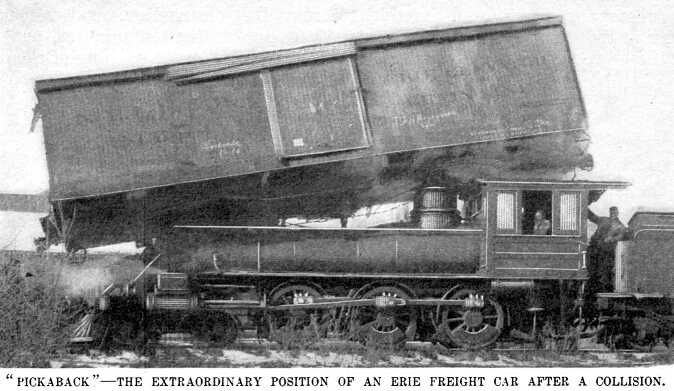
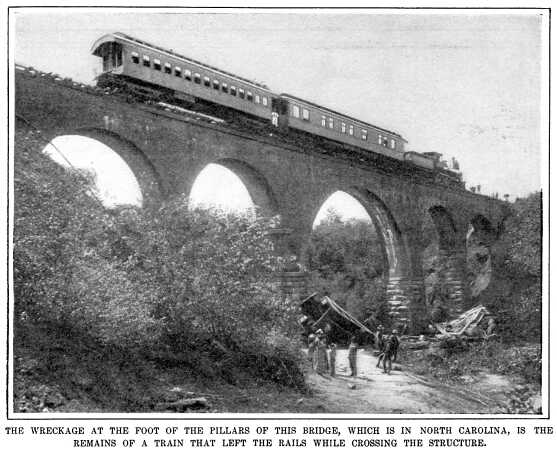 Neither the
engineer nor the telegraph operator waited to hold any conversation,
for the little building had been placed close to the track, entirely
too near for safety under these new conditions. So the engineer
scrambled through the window, and the telegraph man took the door,
and when outside, both of them ran up a steep bank beside which
the track was located. It is not certain about the telegraph man,
but the engineer was so great a coward that he covered his face
with his coat—in order that he should not see the inevitable
catastrophe—and waited.
Neither the
engineer nor the telegraph operator waited to hold any conversation,
for the little building had been placed close to the track, entirely
too near for safety under these new conditions. So the engineer
scrambled through the window, and the telegraph man took the door,
and when outside, both of them ran up a steep bank beside which
the track was located. It is not certain about the telegraph man,
but the engineer was so great a coward that he covered his face
with his coat—in order that he should not see the inevitable
catastrophe—and waited.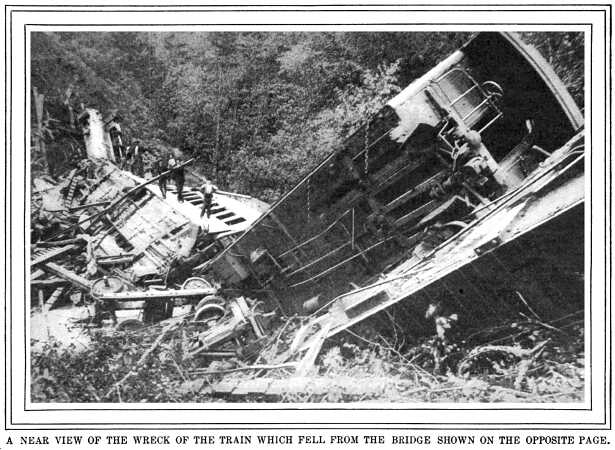 It may easily
be believed that this second wreck complicated an already difficult
situation. It was a simple thing enough to haul away the passenger
cars, and this was done upon the arrival of the first locomotive
with supplies. But the passenger engine was in a very precarious
position, and it was worth about eight thousand dollars. Any attempt
to move the wreckage under it would result in tipping it over,
to its probable destruction; and it successfully resisted every
effort to draw it back by the way it came. Finally, when valuable
time had been lost in trying to save it in good condition, it
was stripped and rolled out of the way; and a curious looking
machine it was when it reported at the shops for repairs. By reason
of the delay caused by the second accident, the time necessary
for cleaning up, and for building a trestle and a new track, was
extended from twelve hours—the original estimate—to
fifty five hours.
It may easily
be believed that this second wreck complicated an already difficult
situation. It was a simple thing enough to haul away the passenger
cars, and this was done upon the arrival of the first locomotive
with supplies. But the passenger engine was in a very precarious
position, and it was worth about eight thousand dollars. Any attempt
to move the wreckage under it would result in tipping it over,
to its probable destruction; and it successfully resisted every
effort to draw it back by the way it came. Finally, when valuable
time had been lost in trying to save it in good condition, it
was stripped and rolled out of the way; and a curious looking
machine it was when it reported at the shops for repairs. By reason
of the delay caused by the second accident, the time necessary
for cleaning up, and for building a trestle and a new track, was
extended from twelve hours—the original estimate—to
fifty five hours.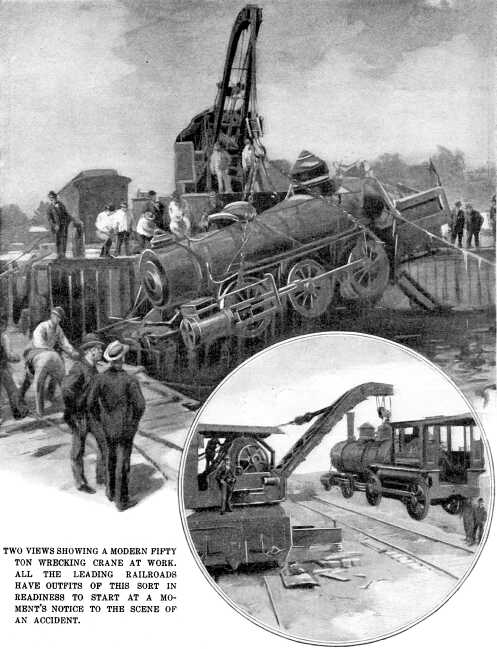 "NEGLIGENCE
IN OPERATION."
"NEGLIGENCE
IN OPERATION."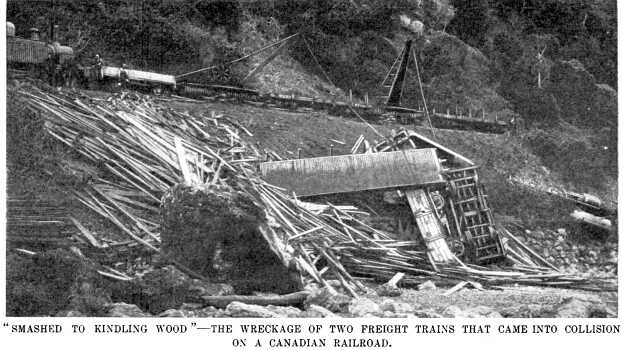 It is not necessary
to carry the description of this particular affair any further
than to say that it was cleaned up in the usual way, there were
a few more than the usual number of dismissals from the force,
and, although it presented its full share of remarkable coincidences—what
wreck does not, indeed?—it is probable that but few of those
who were there would today he able to identify it from this account,
so common have such occurrences been in the recent past of American
railways
It is not necessary
to carry the description of this particular affair any further
than to say that it was cleaned up in the usual way, there were
a few more than the usual number of dismissals from the force,
and, although it presented its full share of remarkable coincidences—what
wreck does not, indeed?—it is probable that but few of those
who were there would today he able to identify it from this account,
so common have such occurrences been in the recent past of American
railways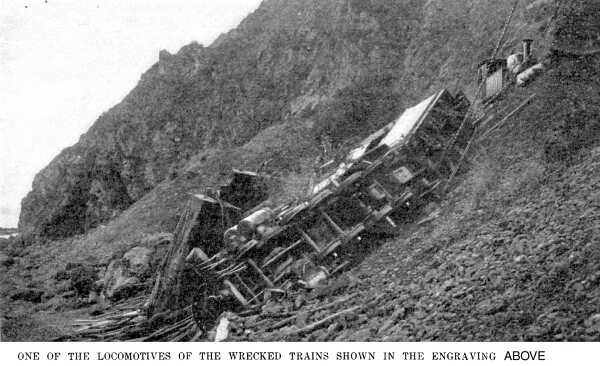 Some of the
true stories which arc told about the performances of rolling
stock under unusual conditions are stranger than the most lurid
fiction. A pair of locomotives in a Græco Roman wrestling
match; another pair which meet in a collision, turn end for end,
and then-pass each other exactly like the figure "balance
corners" in a quadrille; a car which takes a run past those
in advance, and is found practically uninjured—except that
it' dropped its trucks on the way—six car lengths ahead;
all these strange things are of record, and the list might be
almost indefinitely extended.
Some of the
true stories which arc told about the performances of rolling
stock under unusual conditions are stranger than the most lurid
fiction. A pair of locomotives in a Græco Roman wrestling
match; another pair which meet in a collision, turn end for end,
and then-pass each other exactly like the figure "balance
corners" in a quadrille; a car which takes a run past those
in advance, and is found practically uninjured—except that
it' dropped its trucks on the way—six car lengths ahead;
all these strange things are of record, and the list might be
almost indefinitely extended.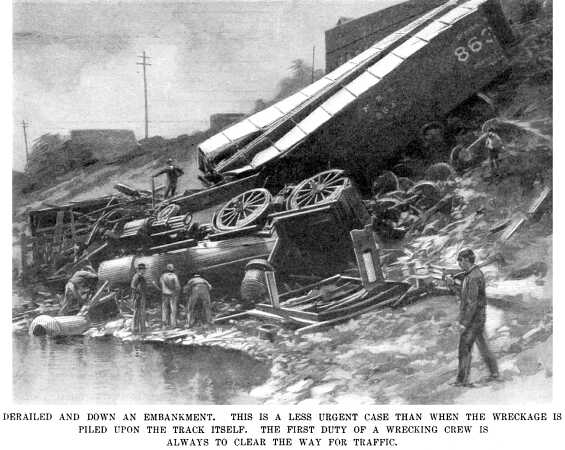 HOW RAILROADS
DEAL WITH WRECKS.
HOW RAILROADS
DEAL WITH WRECKS.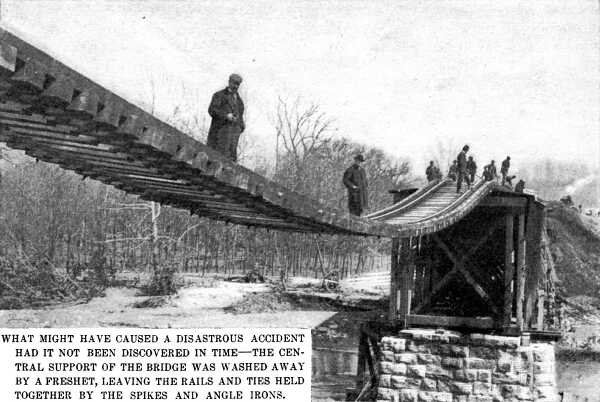 The permanent
attendant assigned to the wrecking train is often provided with
a living room in the tool car, and spends his nights there. He
looks after the contents, sees that everything is keyed up to
the highest note of efficiency, and can put his hand on anything
that is wanted, even in the dark; in fact, he is the most important
tool of the outfit. One of his duties, and not by any means the
least of them, is to prepare hot coffee and lunches for the men
while they are engaged in wrecking; for it must be remembered
that there is no meal time or rest hour so long as traffic is
interrupted; hence the tool car, in addition to the implements
just named, always should be, and most always is, supplied with
a stock of ground coffee and a coffee boiler.
The permanent
attendant assigned to the wrecking train is often provided with
a living room in the tool car, and spends his nights there. He
looks after the contents, sees that everything is keyed up to
the highest note of efficiency, and can put his hand on anything
that is wanted, even in the dark; in fact, he is the most important
tool of the outfit. One of his duties, and not by any means the
least of them, is to prepare hot coffee and lunches for the men
while they are engaged in wrecking; for it must be remembered
that there is no meal time or rest hour so long as traffic is
interrupted; hence the tool car, in addition to the implements
just named, always should be, and most always is, supplied with
a stock of ground coffee and a coffee boiler.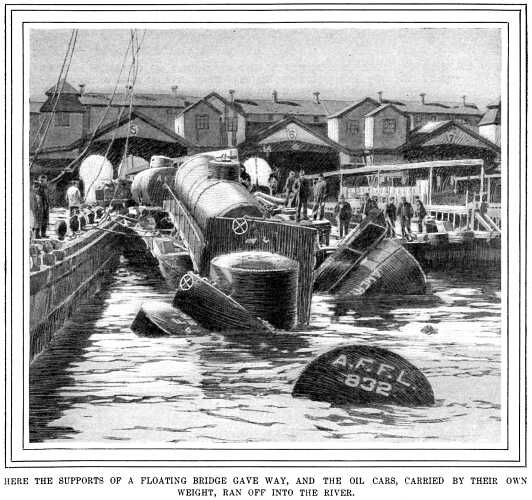 While the work
lasts he is everywhere, with both head and hands busy. He ties
a rope here, directs the placing of a jack there, and has one
eye always on the lookout of the lives and limbs of his men. To
his own safety he seems to pay little heed, but here him rebuke
some over daring member of his gang in a language especially chosen
for its strength! Ropes and chains will sometimes break under
a pull; jacks have been known to slip from their bearings, and
cars are not unlikely to topple further than they are expected
to; and when such things occur it is not rarely that there is
a case for the hospital, if not indeed for the priest. To work
in and around a wrecking gang is scarcely the safest place in
the world, and it rests with every one to "watch out."
While the work
lasts he is everywhere, with both head and hands busy. He ties
a rope here, directs the placing of a jack there, and has one
eye always on the lookout of the lives and limbs of his men. To
his own safety he seems to pay little heed, but here him rebuke
some over daring member of his gang in a language especially chosen
for its strength! Ropes and chains will sometimes break under
a pull; jacks have been known to slip from their bearings, and
cars are not unlikely to topple further than they are expected
to; and when such things occur it is not rarely that there is
a case for the hospital, if not indeed for the priest. To work
in and around a wrecking gang is scarcely the safest place in
the world, and it rests with every one to "watch out."